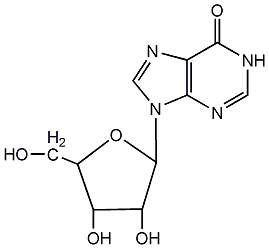
Structural formula
| Business number | 019P |
|---|---|
| Molecular formula | C10H12N4O5 |
| Molecular weight | 268.23 |
| label |
9-β-D-Ribofuranosylhypoxanthine, Inosine;, Hypoxanthine 9-β-D-ribofuranoside, Treat liver disease |
Numbering system
CAS number:58-63-9
MDL number:MFCD00066770
EINECS number:200-390-4
RTECS number:NW7460000
BRN number:624889
PubChem number:24896051
Physical property data
1. Properties: White needle-like crystals. Odorless. Slightly bitter taste.
2. Density (g/mL, 25/4℃): Undetermined.
3. Relative vapor density (g/mL, air=1): Undetermined
4. Melting point (ºC): 218℃ (decomposition)
5. Boiling point (ºC, normal pressure): Undetermined
6. Boiling point (ºC, 5.2kPa): Undetermined
7. Refractive index: Undetermined
8. Flash point (ºC): Undetermined
9. Specific rotation (º): [α]D18-49.2° (C=0.9, in water), [α]D22-52.6° (C=2.5, water)
10. Autoignition point or ignition temperature (ºC): Undetermined
11. Vapor pressure (kPa, 25ºC): Undetermined
12. Saturated vapor pressure (kPa, 60ºC): Undetermined
13. Heat of combustion (KJ/mol): Undetermined
14. Critical temperature (ºC) : Undetermined
15. Critical pressure (KPa): Undetermined
16. Log value of oil-water (octanol/water) partition coefficient: Undetermined
17. Explosion upper limit (%, V/V): Undetermined
18. Explosion lower limit (%, V/V): Undetermined
19. Solubility: 20℃ 100ml of water dissolves 1.6g of product. Slightly soluble in dilute hydrochloric acid and alkali hydroxide solutions, very slightly soluble in ethanol. It is easily hydrolyzed in dilute inorganic acids to produce hypoxanthine and D-ribose.
Toxicological data
1. Acute toxicity: rat oral LD50: >10000mg/kg; rat intraperitoneal LD50: 2900mg/kg; rat intravenous LD50: >2mg/kg; mouse oral LC50: >20mg/kg; mouse intraperitoneal LC50: 3175mg/kg; mouse subcutaneous LC50: 5mg/kg; mouse intravenous LC50: >2800mg/kg2. Other multiple dose toxicity: rat oral TDLo: 558mg/kg/93D-C
3. Mutagenicity Sex: DNA damageTEST system: mammal – species not lymphocytes: 60mmol/L
Ecological data
None
Molecular structure data
1. Molar refractive index: 58.89
2. Molar volume (cm3/mol): 128.6
3. Isotonic specific volume (90.2K): 411.3
4. Surface tension (dyne/cm): 104.4
5. Polarizability (10-24cm3): 23.34
Compute chemical data
1. Reference value for hydrophobic parameter calculation (XlogP): None
2. Number of hydrogen bond donors: 4
3. Number of hydrogen bond acceptors: 6
4. Number of rotatable chemical bonds: 2
5. Number of tautomers: 3
6. Topological molecule polar surface area 129
7. Number of heavy atoms: 19
8. Surface charge: 0
9. Complexity: 405
10. Number of isotope atoms: 0
11. Determine the number of atomic stereocenters: 4
12. Uncertain number of atomic stereocenters: 0
13. Determine the number of chemical bond stereocenters: 0
14. Number of uncertain chemical bond stereocenters: 0
15. Number of covalent bond units: 1
Properties and stability
None
Storage method
This product should be sealed and stored in a cool, dry place.
Synthesis method
(1) Corynebacterium fermentation produces inosinic acid, and then chemically removes the phosphoric acid to obtain inosine.
(2) Mutated Bacillus with double auxotrophs for adenine and thiamine strain, one-step fermentation to prepare inosine.
Purpose
1. Biochemical research. It is used medicinally to promote white blood cell proliferation.
2.It is used for leukopenia or thrombocytopenia, liver disease and heart disease.

 微信扫一扫打赏
微信扫一扫打赏

